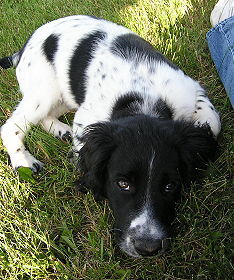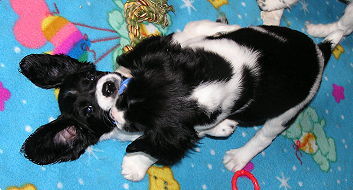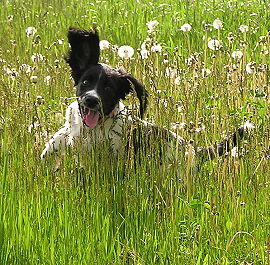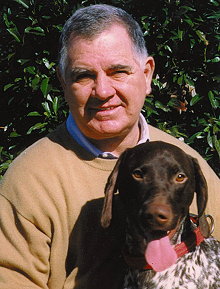
It takes time to teach a dog to trust you and respect your right to set all the rules in your relationship, but it is worth the effort. He will learn this best if you communicate as closely as possible in ways canines - especially dogs and their cousins, wolves - understand. It will also help if you do it systematically.
Once you are certain you have the right attitude for owning and training a dog, you are ready to build the kind of rapport that will help him be a more willing and successful student as you progress further.
The Dog's Perspective
Many writers and researchers say that a dog's primary rule of survival is to have a stable pack order - a hierarchy which is formed through ritualistic and constant testing of dominance and submissiveness. A pecking order, if you will. Even those who counsel others on canine behavior, including people who hold doctoral degrees, have differing viewpoints on what motivates a dog's behavior. So, it helps to understand each expert's philosophies and beliefs, as well as their frames of reference, for behavior, behavioral theory and interpretation.
Before we can draw any conclusions on our own, we should consider such issues as leadership versus dominance; submissiveness versus subordination. Offering one viewpoint, Drs. Benjamin and Lynette Hart (Canine and Feline Behavioral Therapy, Lea & Febinger, Phila., 1985) report:
"In groups of social animals, peace is maintained by the existence of dominant-subordinate relationships. There is an inherent tendency for animals to strive for the top position." The authors also add: "Since dogs relate to people as they would canine members of a pack, there is the potential for dogs to attempt to assume a dominant position over their owners."
Elsewhere in the book, they say, "Conflicts that arise are resolved by a threat from one animal and then, usually, a submissive gesture from its opponent. Dog problems are often centered around the dominance hierarchy issue, and time after time, issues relating to dominance come up in problem behavior."
Other authorities, in personal communication, have expressed a contrary view - that what dogs do with dogs has little or no relevance to what dogs do with people, or people with dogs. Based upon our experiences with thousands of dogs and owners, we have concluded that people who harbor that view are in the minority.
"In fact, even the terms, dominance and submissiveness, may be inappropriate for describing dogs' interactions when they are sorting out pack status or "pecking order"."
There may not be one simple answer. Dog Behavior -- The Genetic Basis (University of Chicago Press, 1965), by Drs. John Paul Scott and John S. Fuller, suggests other viewpoints on this subject. Their book, the foremost authoritative book in the field, is the one many experts seem to draw from the most.
Scott and Fuller say, "The behavior patterns of wolves are different from other canidae in only minor ways." - p. 415. And, on page 416, they add, "Thus the development of social behavior in dogs is directly related to the type of social organization typical of adult wolves and dogs allowed to run wild in packs."
On the same pages, the authors expand, "When sociallized to people, both dogs and wolves transfer to human beings the social relationships which they would normally develop with their own kind insofar as this is permitted by their owners. Dogs do not acquire human behavior through this association, but continue to show the dog-like patterns of behavior common to all the Canidae." And later, "People transfer their social relationships to dogs and attempt to teach them human social customs and new skills. The result is a relationship which is neither typically human nor typically canine. The dog is no longer an equal member of the pack, although he will develop along these lines if allowed. Rather, he becomes a perpetual follower and dependent." Then on page 417, where the authors talk about the puppy's early developmental period, they write, "During this period, it is easy to transfer social relationships to another species by experimental means."
On page 80, Scott and Fuller note that "No human being can wag his nonexistent tail, and no dog can pick up things with his paws. Human beings are basically different in anatomy, physiology, and behavior." They also add, "At the same time, social behavior patterns are similar enough so that many of them are mutually recognizable and each species can give appropriate responses to the other's behavior in many situations."
They then go on to say, "One general characteristic of behavior which makes dogs highly adaptable as domestic animals is the tendency to treat human beings as though they were fellow members of a pack, even if the 'pack' is reduced to one other member."
Adds Dr. Scott, in personal communication with me, "There is considerable confusion in the literature concerning wolves between the concepts of dominance and leadership; the most dominant animal in the pack being called the 'pack leader,' although this animal is rarely a leader in the sense of setting or signaling an example that is followed by others. Movements of wild wolf packs are often coordinated, but may be initiated by almost any adult.
"Dominance, on the other hand," Dr. Scott continues, "means that in any given paired competitive situation, one animal consistently wins and the other loses. This is called a dominance-subordination relationship and tends to be quite stable once developed. A subordinate animal occasionally challenges the dominant one, but what causes this to happen is not known. In the case of a challenge, the subordinate may win, but not often." He went on to say, "From the dog-training viewpoint, the important thing is that the control exercised by the dominant animal is almost entirely negative. The dominant animal can cause the subordinate one to give up a bit of food, to stop attempts at mating, et cetera. But it can not say, 'If you will help me hunt that caribou I won't bite you."'
Dr. Scott adds: "In the dog-human relationship, the human must be dominant; otherwise his pet will bite him if he does something the dog doesn't like. However, it is not necessary to establish dominance by severe punishment or a knock-down and drag-out fight. Such techniques are undesirable in that pain is a stimulus that provokes aggression."
Doctor Scott continues, "We found in our experiments that dominance could be established in young puppies without any punishment whatever, simply by carrying the young puppies around, i.e., using restraint instead of punishment. This does not stimulate the puppy to rebel, as does pain. In the case of the average dog owner, restraint will be supplemented by mild punishment used to make the puppy stop certain undesirable activities. Here again," he adds, "we can get a hint from the behavior of the dogs in the dog-dog relationships. Bitches dominate their pups in order to make them stop nursing and to wean them, but they almost never bite; it is all done with threats and vocalizations. The human can use similar techniques on his puppy." Doctor Scott goes on to say, "Humans achieve something new; a true leader-follower relationship in which the person directs the behavior of the dog by signals, often at considerable distances. It is achieved primarily by rewards for the desired activity: food, petting, praise, etc..."
Lead vs. Dominate
In our view, we should differentiate between the terms "lead" and "dominate." An owner's ability to dominate his or her dog may have very little to do with success in resolving most behaviors owners call problematical. To illustrate, many people who have tried what is called an "Alpha Roll" or "Alpha Takedown" - clearly an attempt at dominance - have been bitten by their dogs. However, leadership skills - as dogs display and use them - are another story. In fact, even the terms, dominance and submissiveness, may be inappropriate for describing dogs' interactions when they are sorting out pack status or "pecking order".
Dominance behaviors are implicitly threatening and whether they succeed depends upon a submissive response from the other dog. Acquiescence in one instance does not mean the dominated dog will follow the other dog's leadership in future encounters. By contrast, leadership behaviors are generally non-threatening by nature and tend to enhance the likelihood of compliance in future encounters.
While both are established and maintained through body language, vocalizations, behavioral consistency and other transactions, the outcomes are distinctly different. Dominance, expressed primarily through intimidation, has a short-term effect and is highly situational. Leadership may include dominance behaviors, but is established more through transactions that build trust, bonding, a willingness to follow and more. It tends to have a long-term effect and is far more stable than dominance.
Thus, I believe we should differentiate dominance from leadership. We might consider the concept of "leader" and "follower". This has support in the work of Mech, Schenkel and others who study wolf ethology. In our view, dogs don't need to be dominated, but all dogs need to be led.
"...most of what dogs do is perfectly natural... for dogs."
More Definitions
We should also consider two other terms when we refer to dog training and behavior: We say "correct" or "discipline" your dog. But often, the action we intend people to take is a form of punishment. Snap the leash, do a "dominance down" or an "Alpha roll", smack the dog with a rolled up newspaper - all are forms of punishment. None fit the definitions for "correct" or "discipline."
Terms Defined
The dictionary is very clear about this. The first definition for "correction" in Webster's New World, Second College Edition, is "a change that corrects a mistake." Punishment is listed as the fourth meaning. The first definition of the word "correct" is "to make right." "To punish" is, again, the fourth meaning. The term, "discipline," is also clearly defined. The second meaning - which is the one that applies here, is: "A training that develops self-control, character, or orderliness and efficiency". The concept of punishment is listed down in fifth place.
Actions Speak Louder
By contrast, consider the dictionary definition for punishment: "to cause to undergo pain, loss or suffering for a crime or wrong doing." The dictionary goes on to say that punishment "generally connotes retribution rather than correction (to punish a murderer by hanging him)." It also says that "discipline suggests punishment that is intended to control or to establish habits of self-control (to discipline a naughty child)," and that "correct" "suggests punishment for the purpose of overcoming faults (to correct unruly pupils)."
These definitions still associate "discipline" and "correction" with punishment. However, the explanations for both words imply the intend of acting in a way that helps the punished individual improve - either by learning control or by overcoming faults. Here we're talking about faults from the human point of view. As we have noted elsewhere, most of what dogs do is perfectly natural... for dogs.
"Correct" should be used to mean "to show the dog how to carry out what you consider the right response." The word "discipline" should be used to describe action taken in a way that will "help the dog develop consistency in its responses."
Since the dictionary says punishment suggests retribution not correction, that raises another issue: When dogs interact with one another, do they ever seek "retribution"? Doubtful. For that matter, are their interactions intended to "discipline" or "correct" one another? To my knowledge, there is no evidence that dogs display such cognitive behaviors - and cognition is implied in the definition of each word.
So, since dogs' don't "punish" other dogs, or "discipline" or "correct" one another, what does take place? Can we can attribute dogs' interactive behaviors to dominance and subordinance rather than punishment, correction and discipline? To me, dogs either assert or forfeit rights. It seems to be that uncalculated... that simple.
In summary, I believe we should:
Back to Learning
Concerning genetics and learning, Doctor Scott says, "In any behavior there is some genetic variation. There are average differences between breeds, with considerable overlap, and a great deal of individual variation within breeds. This means that training methods should be adapted to the breed and to particular individuals within that breed, in order to get maximum results. No one rigid training method will work equally well on all animals."
Preserving Puppy-like Behavior
The works of Scott and Fuller also allude to another concept that deserves close attention: That successful relationships between people and their dogs may exist because of what can be termed behavioral neoteny, or the maintenance by owners of desirable, puppy-like behaviors in their dogs.
As additional support for this theory, consider the work of Dr. Ian Dunbar, of the University of California, Berkeley. He points out on page 214 of Dog Behavior -- Why Dogs Do What They Do (T.F.H. Publications, Neptune, NJ, 1979) that our society tends to favor dogs that retain their desirable, puppy-like behavior patterns while eliminating the undesirable ones. He says that this quality in dogs, behavioral neoteny, is "highly adaptive".
Examining this against Scott and Fuller's comments that each species can give appropriate responses to the other's communications, we conclude that dogs may be flexible enough to accept human attempts to mimic their behaviors - even though people may leave out a few of the elements.
What Starfire has developed based upon the research is a series of activities that owners, trainers, behaviorists and handlers can carry out with dogs that come close to how adult dogs would act toward puppies. Each is designed to help establish a relationship with the dog that reminds him that you want him to maintain certain desirable, infantile or juvenile behaviors in his interactions with you.
No one has yet devised a way to ask the dog how he thinks or feels, or why he acts or reacts as he does. So, people can only observe what dogs do, when they do it, and what the outcome is, in general. It is safest to assume that most will try to take charge unless - or until - their owners have established a proper leadership role over them through the Rapport Skills© we at Starfire developed.
In working with more than 400 clients' dogs over a two-year period, we developed a number of activities based upon the concepts described and had owners try them with their dogs. Since some dogs responded negatively to a few of these activities when they were introduced in a random sequence, we arranged these exercises in a hierarchical sequence based upon which ones dogs were most likely or unlikely to accept, at first. Once owners were able to use the Rapport Skills© to build - or rebuild - a relationship, gradually they were more successful regardless of their dogs' temperament or previous behavior problems.
In more than 40 of those client cases where dogs exhibited dominance behaviors - ranging from 6 to 10 on our scale of 1-10 with 10 being a dominant-aggressive dog that had bitten its owners - the dogs initially resisted the owner's efforts to carry out the Rapport Skills© exercises. Once the owners gained their dogs' acceptance of the initial exercises, progress in reordering the hierarchy came more rapidly.
Over the years since then, I have demonstrated that these Rapport Skills© can play a major, significant role in helping owners establish, reestablish, maintain or reinforce their leadership over their dogs. And we have shown that this is an important preface to sound behavior-modification over time. In fact, many of the owners who had the least long-term success in overcoming behavior problems generally had either skipped one or more of the exercises, or had stopped using them - sometimes after their dogs were rehabilitated to their initial satisfaction.
You can do most of these interactions with your dog either in the house or yard as a normal part of your daily activities. No formal training sessions are required. Some owners and their dogs go through the entire series rapidly and successfully. But keep in mind that the interactions are cumulative. You shouldn't start with the second exercise until you are successful with the first one, and so on. However, you keep doing exercises one and two when you start the third one. In fact, as your training progresses, you should always routinely carry out the ones you have already established up to the level you are working on. The more successes you have every day, the more you reinforce the desirable behaviors in your dog. If you maintain these Rapport Skills© consistently for the rest of your dog's life, he will be more willing to do as you bid.
Most owners succeed at all the exercises in about ten days. However, it could take longer since you will be working to change - in a matter of weeks - problems that may have developed over months or even years.
In part two, appearing in our next issue, Steve details specific exercises designed to help you establish and preserve your leadership role within your relationship with your dog. © 1989, Stephen C. Rafe. All Rights Reserved.
|



